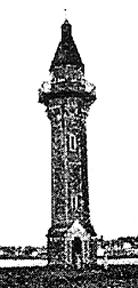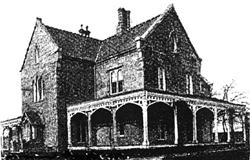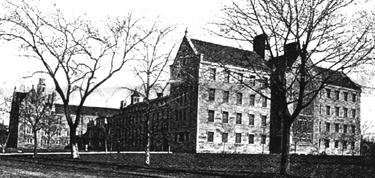From the 1995 special issue of Correction News marking DOC's centennial:Before Rikers Island became Correction's chief island base, Blackwell's Island filled that role. Blackwell's was the name that for nearly two centuries identified what is now known as Roosevelt Island, whose aerial tramway cable-cars gliding over the East River can be seen from the Queensborough Bridge. The cigar-shaped 120-acre isle beneath the bridge extends 1.75 miles and is 750 feet across at its widest point. Gov. Van Twiller reported obtaining it for New Amsterdam from native tribal leaders in 1637. Then the Dutch settlers put their pigs to pasture there, generating its early Colonial name of Hog Island. In 1652, a man named Flyn acquired the island but 16 years later a British military captain, John Manning, bought it. Unhappily for him, he presided over the surrender and brief return of the city to Dutch rule in 1673. For this, his sword was later symbolically broken in a City Hall ceremony of disgrace. Afterwards, Manning retired to his island refuge. His stepdaughter married Robert Blackwell who took title to it in 1717. New York City acquired the island on July 19, 1828, through a foreclosure -- later ruled to have been illegal. Total final price: $52,500.
As far back as 1796, the State Legislature mandated two state prisons: one in Albany; the other, in New York City. The first such New York City-operated state prison was Newgate, opened 1797 in Greenwich Village. In 1816, Newgate was replaced by a penitentiary near Bellevue Hospital. In 1832, the main building of the Blackwell's Penitentiary was erected. In 1848 the Bellevue complex was divided, one reason being the intent to move all its inmates to Blackwell's. A decade later, the north wing was added to Blackwell's Penitentiary. The complete facility housed nearly a thousand inmates, most serving misdemeanor sentences but all were required to perform some daily labor, the tasks varying according to inmate skills and strengths. The Blackwell's Workhouse was built in 1852 to replace a century-old similar facility at Bellevue. Containing 221 cells arranged in tiers along the three-story walls of granite, the building functioned as an institution for punishment of petty violators, many of whom were classified as habitual "drunks and disorderlies," including several who virtually became permanent residents even though the usual stays were counted in days.
However, the DOC-creation law of 1895 specifically declared that workhouse inmates might work on Public Charities grounds and buildings, under the "oversight and direction of keepers, but no inmate of the workhouse shall be employed in any ward of any hospital." The facilities the city constructed on Blackwell's -- the Charity Hospital, Penitentiary, Alms House, Hospital for Incurables, Workhouse, Asylum for the Insane, among others -- were built of granite in the fortress style from feudal times. All were erected with convict labor as was the seawall around the island. About the time DOC became a separate agency, Blackwell's housed a population of approximately 7,000 _ inmates and patients. Visitors needed agency permits to come across by the ferry that made the round trip from East 26th St. twice daily. Department steamboats transported inmates between the Tombs and Blackwell's Island.
The Penitentiary stood 600 feet long with a projecting wing on the north side. The main building was constructed with gray stone taken from island quarries. It rose four stories high in a castle-like design and had 800 cells in four tiers back-to-back in the center of the structure. Scandals in the early 1900s, involving charges of inmate overcrowding, drug-dealing, and favoritism, prompted surface "reforms," including a change made by Aldermen on April 12, 1921, to a more pleasant-sounding name: Welfare Island. Nevertheless, the Penitentiary remained in place even though the language of the law creating DOC clearly had sought eventual removal of inmates from Blackwell's to Rikers and Hart Islands. That transfer didn't happen in earnest until scandals in the 1930s led to real reform during the administration of Mayor Fiorello LaGuardia. In January 1934, LaGuardia's reform Correction Commissioner, Austin H. MacCormick, led a raid on the Welfare Island penitentiary to expose conditions. This brought about the removal of all inmates to Rikers Island, where new facilities were just being completed. Welfare Island was turned over exclusively to the care of the aged and the ill.
To Blackwell's Part 2: The Gallery
To Blackwell's Part 3: The Island in 1872 |




